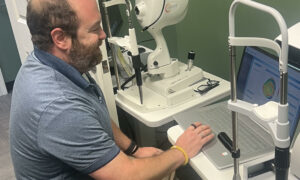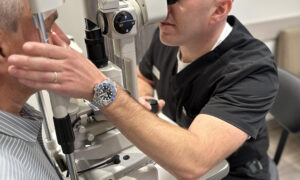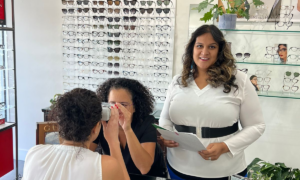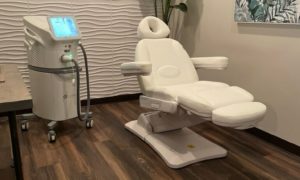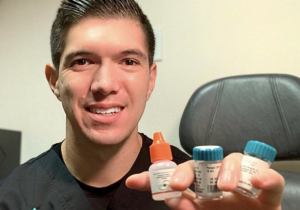
Dr. Neufeld holding myopia management supplies: atropine drops and Ortho-K lenses. He says that with the right investments, adding this service to your practice can be a significant win for both patients and practice.
Maximizing the benefits of myopia management for patients & practice alike.
By Aaron Neufeld, OD
May 1, 2024
From both a revenue-generation perspective and patient/practitioner standpoint, myopia management/control is the most beneficial specialty in my private practice.
In fact, after a thorough analysis of my practice’s financials in 2023, I found that myopia management/control accounted for over $75,000 in bottom-line revenue (this figure was derived after staff/doctor time + cost of goods were factored out of initial gross revenue. We are able to calculate this through our EHR and the unique codes we assign to myopia management patients)
The combination of myopia management/control’s niche service offering, high-profit margins and the “moat” it creates against competition and disruption, make it a great value-add to nearly any practice for both patients and clinicians alike.
In lectures I give for continuing education and industry, I often refer to myopia management/control as “Optometry’s Wishing Well” due to the fiscal advantages it can offer practice owners.
In this article, I’ll break down how to introduce myopia management into your practice and turn it into a rewarding, revenue-generating practice builder.
Investments Needed
First, it’s important to account for the investments needed to make myopia management/control feasible. To accommodate treatment via orthokeratology, dual-focus soft contact lenses and low-dose atropine, a clinician needs a corneal topographer and either b-scan or biometer (to measure axial length), in addition to standard lane equipment.
Personnel costs include training support staff on presenting myopia management/control programs and conducting trainings, while associate doctors need to be trained/certified and coached on how to present to and educate patients on myopia management/control.
Other ancillary costs include stocking solutions, accessories and possibly contact lens revenue boxes in the office.
Investment Bottom Line: All in all, a practice can be fully ready to offer a robust myopia management/control program with an investment of under $40,000.
Other Articles to Explore
Presentation – Global vs. Individual Fee
Fees for myopia management/control can be presented either individually or as a collective global fee. There is no right or wrong way of approaching this, but it is important to denote the impact of fee-setting methodology.
Individual fees denote each method of myopia management/control as an a la carte service with a set value. Certain methodologies carry a higher fee (most often Ortho-K), while others carry a lesser fee (most often low-dose atropine carries the lowest fee).
Global fees present myopia management/control as a unique clinical service that caters its offering to the patient’s individual need.
In my practice, we utilize a global fee (as do many of the leaders in myopia management) due to its unique presentation ability, simplicity and also its propensity for higher revenue generation.
Operations
When bringing an effective myopia management/control program into a practice, owners must ensure that a specific set of operations govern how the program will operate. This includes training staff properly, properly identifying candidates, educating patients during exams and/or consults, creating patient contracts/brochures and properly scheduling both initial visits and follow-ups.
While every practice will have unique schedules and staff dynamics, thus creating unique operational sequences, here are three things that most helped us grow our own program:
- Identifying Candidates in the Chair – Think of all the children/teens you have seen over the last year. If they’re myopic, have a family history of myopia, or have high-risk behavior (increased screen time and sedentary tendencies); then they’re a potential candidate. However, the patient and their parents will only know about myopia management/control if you as the practitioner educate them on it. Another important item to note: if you can provide a preventative treatment versus a corrective treatment, shouldn’t the preventative treatment be offered as first line?
- Providing a Free Consultation Appointment – We have many new patients who either find our practice or get referred to us for myopia management. To properly educate and prepare these patients for a great experience, we offer a free consultation visit. In this 20-minute appointment, we conduct tests to ensure that the patient is a good candidate, and that both the patient and their family are well educated on treatment. Nearly 95 percent of our free consultation result in a signed contract and scheduled initial appointment before the patient leaves the office.
- Having a Myopia Management Champion – While it may be excessive to have a staff member solely dedicated to myopia management, it is important to have a point person who knows myopia management/control inside and out. We colloquially refer to this individual as our myopia management champion. They set up appointments, discuss fees and walk the patient/parents through questions from a non-clinician standpoint. This individual helps patients feel more at ease, and also facilitates the progress of these patients to ensure efficiency.
Marketing
Now that you have a great niche service to offer the public, how do you get the word out? Simply put, a combination of both internal and external marketing is needed. Most practices see a significant source of patients come from those already in the practice as they are identified and educated as candidates during their annual exams.
External marketing can be done many ways. Being present at events that involve children and their parents is a great way to get the word out. An even better way is targeted online advertisements through both search engine (Google Ads) and social media. For these ads to be effective, they must be extremely specific in their targeting.
For clinicians who find this too daunting to do on their own, ODs on Finance is proud to partner with two of the leading companies in this space as part of our Practice Owner Resource website.
Help Patients While Differentiating Your Practice
In conclusion, myopia management/control is a great way to differentiate your practice, add additional revenue and provide a much-needed service to children and teen patients.
With its unique ability to protect against the disruption and competition that so many other facets of optometry face, it’s time for more practitioners to get serious about stopping myopia and take the necessary steps to bring myopia management/control to their practices today.
 Aaron Neufeld, OD, is the owner of Los Altos Optometric Group in Los Altos, Calif., and of Pacific Eye Care Optometry in Mountain View, Calif. He also is co-founder of ODs on Finance. To contact: aneufeldod@gmail.com
Aaron Neufeld, OD, is the owner of Los Altos Optometric Group in Los Altos, Calif., and of Pacific Eye Care Optometry in Mountain View, Calif. He also is co-founder of ODs on Finance. To contact: aneufeldod@gmail.com





